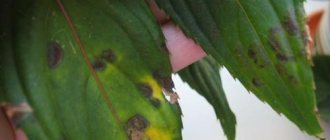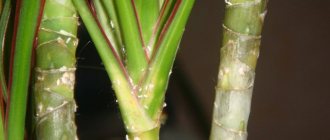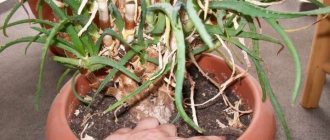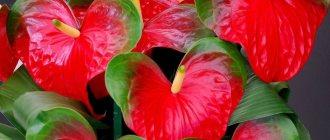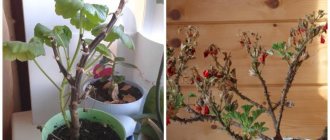Author: Elena N. https://floristics.info/ru/index.php?option=com_contact&view=contact&id=19 Category: Houseplants Published: August 6, 2012Republished: February 5, 2019Last edits: March 19, 2021
Caring for plants can bring both joy from the sight of beautiful and healthy flowers, and grief from failures: if a plant sheds its leaves, does not bloom, withers and dies before our eyes, inexperienced gardeners begin to panic, not knowing how to save their favorite flower. However, there are no hopeless situations; you just need to know where to look for a solution to the problem. In this article we will tell you about the symptoms of the most common plant diseases, as well as the causes of their occurrence.
Irregular watering
For some indoor plants, proper watering is a fundamental issue. But brown leaf tips can also appear in unpretentious plants. This usually happens when the grower first overwaters the plant so that it drowns, and then barely drizzles the next time.
Houseplants, with the possible exception of succulents, require regular watering. Within one season, the amount of water and frequency of watering should remain constant. You can’t pour a lot once and not enough the second time, because the ground is not as dry as the last time. This will definitely result in brown leaf tips. Pour until water drips from the bottom. Always water at regular intervals.
Light (white or yellow) spots on tomato leaves
Are you wondering what to do if white or yellow spots appear on the leaves of your tomatoes? Firstly, do not panic, and secondly, read the text below and begin to fix the problem.
Septoria or white spot
Symptoms . The disease begins to spread from the lower leaves, then moves higher and affects the stems, flowers and fruits of the plant. Smooth round spots of dirty white or gray color, bordered by a brown stripe, appear on the leaf plate. Over time, the spots “spread”, the leaves curl, darken and dry out.
Control measures . Affected plants are destroyed, the greenhouse is disinfected, and the soil is dug up. To prevent white spotting, tomatoes are sprayed with 1% Bordeaux mixture, 0.3% copper oxychloride suspension or a solution of Baktofit.
It is important to observe crop rotation and return tomatoes to the same area no earlier than after 3 years.
Mosaic of tomatoes
Symptoms . The disease spreads very quickly to nearby tomato bushes. Chaotically located yellow or light green spots appear on tomato leaves. In young leaves, the mosaic pattern is more clearly visible than in older leaves.
Control measures . Even before sowing, the seeds are disinfected to prevent infection with the mosaic virus. At the initial stages of the disease, an adult plant is treated with a 0.05% Farmayod solution or a 10% whey solution.
Chlorotic curl, or tobacco necrosis mosaic
Symptoms . The spreader of the virus is the whitefly. The top of the tomato bush begins to curl, light spots with a yellowish tint are found on the surface of the leaves, which gradually spread and merge together.
Control measures . Sick plants are destroyed along with their roots, and the greenhouse is disinfected. The remaining bushes are treated with a 1% solution of Bordeaux mixture. For prevention, treatment against pests is carried out: the bush is sprayed with Biotlin, Fitoverm, etc.
Cladosporiosis, or brown (olive) spot
Symptoms . First, the lower part of the bush is affected, and then yellowish spots appear on the upper leaves of the tomatoes. Subsequently, the spots darken and spread throughout the bush. On the reverse side of the leaves, the space under the spots is covered with a light gray coating (later turns brown). The leaves curl and dry out.
Control measures . Spraying the bushes with a 0.05% solution of Fitosporin-M, as well as Abiga-Pik or HOM preparations. To destroy the fungus that causes the disease, preventively treat tomatoes with biofungicides (Pseudobacterin-2 or Sporobacterin), as well as regularly ventilate the greenhouse.
Insufficiently humid air
For indoor plants native to tropical countries, this is the main cause of brown leaf tips. For them, not only regular and abundant watering is important, but also humidity. The problem is especially acute in winter. Fortunately, it's not difficult to solve.
Spray the plant with a spray bottle every day. Fertilizers can be added to the liquid to simultaneously enhance growth or immunity. Another way to solve the humidity issue is to place containers of water next to the pots. You can avoid brown leaf tips by purchasing a humidifier for your home.
Proper plant care
Anthurium is a tropical plant, so it is not surprising that the plant is quite picky in its care. You definitely need to know about all the features of caring for this flower. If you follow all the rules, the plant will delight its owners with very beautiful flowering, which can last for more than 3 months. In order for the atrium to be as comfortable as possible, it needs warmth, light, suitable soil and fertilizing.
Here's what you should definitely pay attention to.
- The place in which the flower will be located should be light enough, but without direct sunlight. The flower does not like shadows. If possible, place it on the west or east side.
- Monitor the air temperature in the room - it cannot be less than 22 ºС. In winter, move the flower away from radiators and radiators, otherwise the edges of the leaves will begin to dry out.
- Watering anthurium should also be taken very seriously. The plant loves abundant watering. It cannot be overdried, but it is also not recommended to water it excessively. When the top layer of soil becomes dry, this means that the flower can be watered. The higher the temperature of the atrium, the more often it needs to be watered.
- It is better to buy soil for planting a flower at a flower shop; such soil is suitable specifically for anthurium.
- The flower must be fed. In summer and spring, this should be done 2 times a month. It is also better to purchase fertilizers at a specialized point.
- Anthurium needs to be rejuvenated. As it grows, the lower leaves die off and new ones appear. Dry leaves must be removed and the top cut off.
Accumulated salts
Brown tips on the leaves of indoor plants can be a signal that a lot of salts have accumulated in the soil. They get into the ground with fertilizers and hard water.
Naturally, plants need fertilizer once or twice a year. But no more. Just as an excess of vitamins and minerals is bad for human health, too much fertilizer will not bring anything good to the plant. After all, more is not always better, and instead of lush, healthy foliage, we end up with brown leaf tips and a wilting plant.
For the same reason, it is worth paying attention to water for irrigation. Ideally it should be distilled. But often just standing for a while is enough. If you water your indoor plants with tap water, it doesn’t hurt to know its hardness.
However, even with proper care, an excellent gardener will not completely avoid the risk of brown leaf tips. Over time, salts accumulate in the soil even with adequate fertilization and good water.
If you are sure that you did everything correctly, but still see brown tips of the leaves, the plant needs to be transplanted into new soil, getting rid of the soil with accumulated salts.
It is also worth mentioning that lack of good drainage and sufficient watering exacerbates the problem. Since the salts do not go to the bottom of the pot.
Symptoms of plant diseases
Newly purchased plants are losing their leaves.
Plants, like people, can experience stress as a result of changes in their usual conditions, and the first sign of such stress is the loss of leaves by the plant. To minimize discomfort from moving, the plant must be wrapped when transporting in the winter season - protected from cold air.
The leaves fall instantly without losing color or turgor.
- Anthracnose: treatment and prevention, control measures
Most often, such consequences are caused by a sharp change in air temperature or cold drafts. Another reason may be a significant and sharp increase in the amount of light - the lighting intensity must be increased gradually.
Tree-like plants can suddenly lose their foliage if you allow the earthen clod to dry out too much.
The leaves turn yellow and then fall off.
Many plants begin to gradually shed their lower leaves over time - this is a normal biological process that does not require any action. If a plant drops several leaves at once, this is most likely caused by cold drafts or excessive soil moisture for a long time.
The leaves curl and fall off.
Often this symptom indicates that the room is not warm enough, or that the plant has been exposed to cold drafts, or that the soil in the pot does not have time to dry out between waterings.
The lower leaves dry out and fall off.
This may be a sign that the plant is not getting enough water. Another reason for the phenomenon may be too high an air temperature and lack of lighting.
The upper leaves turn yellow.
If the leaves turn yellow but do not wither, this is usually caused by the fact that too hard water is used for watering the plants (the water must sit for at least a day before watering). Another reason may be excess potassium in the soil, given that the plant does not tolerate lime.
The stems and leaves of the plant rot.
This is usually caused by water getting on the leaves or in the leaf rosette when indoor temperatures are low. In winter, the frequency of watering and spraying for almost all plants needs to be reduced.
Brown spots appear on the leaves.
- To prevent the leaves from turning yellow, add this complex to make up for the lack of an important element
If the spots are dry, it is usually the result of insufficient watering. Keep in mind that almost all plants need to be watered immediately after the top layer of soil dries out.
If the spots are soft and damp, then this means that you overdid it with moisturizing.
Yellow or white spots on leaves.
Such spots may appear if the plant is exposed to direct sunlight for a long time (many plants cannot tolerate bright sun). Another reason: the plant is sick or damaged by pests. Spots also appear if the plant is watered with cold water or water gets on the leaves when watering.
The edges and/or tips of the leaves dry out and turn brown.
Most often this happens if the leaves constantly touch a wall, window or some other object. These changes are often caused by too dry air. Try to increase humidity by misting the plant or the air around it with water at room temperature.
Brown or yellow edges of leaves.
This disease is the result of a number of reasons. The edges of the leaves turn yellow or turn brown either from a lack of moisture in the soil or from its excess; due to dry indoor air; when overfeeding plants with mineral fertilizers; due to cold drafts. Such changes occur when the temperature regime is violated - the temperature is too high or too low than the plant needs. Another reason may be excessively strong or, conversely, insufficient lighting.
The leaves have drooped.
This is a symptom of a violation of the watering regime - both excess moisture in the roots and regular lack of it. Leaves may droop if the room temperature is higher than the plant needs and the lighting is too intense. Or if the pot is too small for the plant and the flower needs to be transplanted into a larger container. Other reasons: plant damage by pests or insufficiently high air humidity in the room.
The leaves are turning pale.
The plant may be affected by spider mites or suffer from too much light.
Holes and torn edges on leaves.
This is either pest damage or mechanical damage.
- Septoria: treatment and prevention, control measures
Leaves become discolored.
Lack of light can cause plants with variegated leaves to lose their pattern and become monochromatic.
The stems stretch out, and new leaves grow small and pale.
The plant lacks minerals and needs feeding, or it lacks light. The plant also stretches out if it is not overwintered properly - too high a temperature in the room, unreasonably abundant watering and insufficient lighting.
The plant does not grow or grows slowly.
This is a normal phenomenon for the winter period, since winter is a dormant period for most indoor plants. If the plant is in a period of active growth, but does not develop, then the reason may be a lack of minerals. Development may stop due to the fact that the roots have filled the entire pot, and there is a need to replant the flower. Excess moisture in the soil and lack of lighting can also inhibit plant growth.
The buds are falling.
Bud drop is often caused by the same reasons as leaves drop. In addition, buds fall off due to insufficient soil and air moisture, from a sudden change in lighting, when attacked by pests, or from changing the location of the flowerpot at the time of budding.
Lack of flowering.
One of the main reasons that a plant does not bloom is improper care of it during the dormant period. The plant does not bloom if the air humidity is too low, if there is not enough light, or if too many minerals have accumulated in the soil. Some types of plants do not want to bloom in a spacious pot.
Short flowering.
Flowers can quickly fade from lack of water - from too infrequent or sparing watering, from insufficient air humidity, which can be increased by placing the pot on a tray with wet expanded clay, from heat or lack of light.
Plaque on a ceramic pot.
A green coating indicates excessive watering or poor drainage - the soil does not have time to dry out or excess water does not leave the pot.
A white coating appears when watering the soil with hard water (we remind you: the water must be left to settle for 24 hours before watering) or when over-fertilizing with mineral fertilizers.
You can fight all these troubles, but it’s easier to avoid mistakes in care by strictly following the rules for growing indoor plants. After all, it is easier to prevent a problem from occurring than to look for ways to eliminate it later.
Should I trim off brown leaf tips?
Restoring watering schedules, humidifying the air, and repotting will help prevent brown leaf tips in the future. But what to do with the ones you already have? They will not recover, so it is better to cut them off with sharp scissors or special garden tools.
- 5 mistakes in caring for indoor plants for beginners. Confession of a careless florist
- Why plant leaves turn yellow - 9 common reasons. Indoor plants and plot
Subscribe to our YandexZen channel to find out more!
Causes of blackening of leaves
If damage to a leaf on a living indoor flower is noticed, you should look for the reasons and try to eradicate them. Otherwise, the foliage may dry out completely and the plant will die.
Initially, it is worth recognizing the cause of the disease:
- Dry air - the plant is watered abundantly, but is located near heating devices. All acquired moisture quickly evaporates, not having time to nourish the pet’s greens
- Dust is an inevitable companion of indoor dwellers. If you do not wipe the leaves and do not give the plant water treatments, the accumulated layer of dust can lead to disease. This is especially true for owners of tropical plants (dracaena)
- Mineral fertilizers - a lack of nutrients, as well as an excess, tends to negatively affect the condition of residents of window sills
- Watering - excessive irrigation is a negative measure of care; an overwatered pet will soon turn black and die. With a large amount of water, roots begin to rot in the soil, mold and fungus appear, which provokes the acquisition of blackness, both at the tips and throughout the entire leaf
- Placement is one of the factors in acquiring blackness. Lack of light or, conversely, scorching sun rays can damage delicate greenery
- Mechanical damage also causes deterioration in the appearance of the flower.
- Phytoblight is a disease that appears from the soil. It migrates to the leaves and, sucking nutritional moisture from them, leads to blackening
Thus, the blackness that appears on the leaves of indoor plants is not the reason for the flower being infested with parasites, but a disease caused by household factors in caring for a pet.
